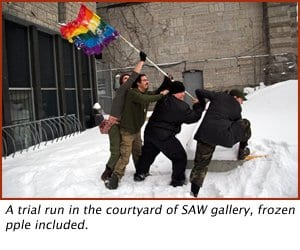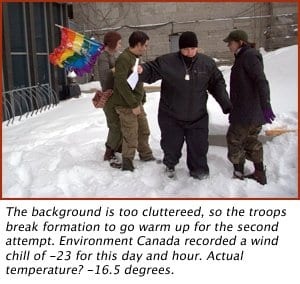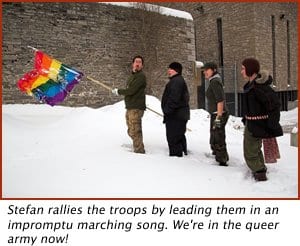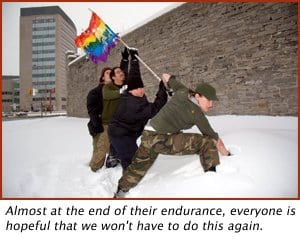Like most of Ottawa’s queer community, our four cover models — each movers and shakers in their own right — came to Ottawa from somewhere else.
Elaina Martin left Sudbury eleven years ago. She’s made her mark on the capital as president of the Westboro BIA and founder of that neighborhood’s free summer festival, WESTfest.
According to Martin, Ottawa is “different than a big city. We’re surrounded by natural beauty; it’s smaller, cleaner, safer.”
And yet, she says, Ottawa has a vibrant art scene and an established queer community.
“There’s no other city that can offer all that,” she says.
It used to be a given that if you were young and queer and born in a small town, you left for Toronto, Vancouver, or Montreal — where half of Canada’s gays and lesbians live. But that’s no longer the case (see cover story).
“When I left Sudbury, there was nothing for creative people to do. Now there is a burgeoning art scene that has just emerged in the last two years,” says Martin.
But even though things seem to be changing, it’s clear that living in a small town can be a challenge for the queer and creative, or the creatively queer.
“Even though there is an art scene now in Sudbury, it’s still so small and so limited,” says Martin. “That scene is still shocked by some of the things that are happening in the urban core.”
Stefan St-Laurent came to Ottawa from Toronto to visit his brother Jason. He ended up staying, becoming curator of SAW Gallery. Now his brother (Inside Out bigwig Jason St-Laurent) even after his brother moved to Toronto to program that city’s Inside Out Festival.
“I’ve been faced with a lot of conservatism in Ottawa and that was what made me uneasy about this city when I first got here,” says St-Laurent. “The first exhibition I curated here with my brother Jason was Scatalogue: 30 years of crap in contemporary art. I couldn’t believe the reaction of the media. It really was quite shocking. We knew that it would create discourse in the city, but I never thought that the media would make up information and relay that to the public.”
But SAW gallery weathered that storm, and in the end came out stronger for the experience. “We never stepped back from the controversy, we always confronted it with as much information as we could, and I think the media respected that in the long run.”
Philippe Hamelin of SAW Video moved to Ottawa from Cowansville, Quebec (by way of Montreal) “for love reasons” but when he got here, he made Ottawa’s arts scene his home.
“What I find exciting about Ottawa is that there is a lot to do, and everything you do has a big impact,” says Hamelin. “it’s smaller but tighter, so you participate in everybody’s projects. What I love about Ottawa is the art scene. I find that there is a real dedication to the art. SAW is kind of an island within the city. I don’t feel like I have to fight for those values of inclusion and diversity, or to bring queer artists here. The center itself wants that to happen. Even if the city is conservative, the art scene is not. Anybody who comes to SAW knows that they are welcome. It’s a place for everybody.”
St-Laurent had a rocky introduction to Ottawa, but gradually he began to feel more at home.
“I started slowly discovering the underground in Ottawa, so my view of Ottawa changed a lot after a year. At first I was really unhappy here.”
Fortunately for Ottawa, St-Laurent managed to find a home in Ottawa’s art community, and is now at the center of a growing local arts scene that continues to produce ground-breaking exhibitions.
“There’s a lot of similarities between Ottawa and the small town I’m from, Moncton,” says St-Laurent. “There is a strong music underground, especially punk music. SAW has always kind of been attached to a lot of underground scenes, and has always been the hub of alternate arts in Ottawa.
Cara Tierney, a well-known performance artist, was born in Ste Anne de Bellevue and went to school in Montreal before making Ottawa her home.
“I left for school, and to be as far away from home as possible. It’s a small town and my parents have big personalities. It was important for me to separate so that I could define myself.”
Like all our cover models, Tierney has big plans for 2008. Cara Tierney continues to mount provocative performance pieces in a variety of venues, and is planning a February performance evening, continuing a local underground tradition of combining performance art with a good old-fashioned house party, this time in Westboro.
Martin is finishing up the programming for the fifth anniversary of WESTfest, which will include a performance art and a media art component. One highlight: a celebration of Canadian aboriginal woman in music including Holly McNarland, lesbian asskicker Kinnie Starr and headliner Buffy Ste. Marie.
Hamelin has programmed Queer Edit at SAW Video this spring. And in the fall they will present the Ottawa component of the Inside Out Festival, in cooperation with Jason St. Laurent in Toronto.
At SAW gallery, queer arts lovers can look forward to Radical Drag: Transformative Performance, a big group show in fall 2008. And the summer blockbuster: Moncton Rock: music and art in the Acadian Capital 1968-2008 music documentation and visual art from the Moncton underground.
Story and photos by Karen Rodgers.








 Why you can trust Xtra
Why you can trust Xtra


